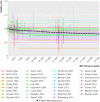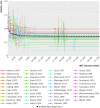Physical activity and risk of breast cancer, colon cancer, diabetes, ischemic heart disease, and ischemic stroke events: systematic review and dose-response meta-analysis for the Global Burden of Disease Study 2013
- PMID: 27510511
- PMCID: PMC4979358
- DOI: 10.1136/bmj.i3857
Physical activity and risk of breast cancer, colon cancer, diabetes, ischemic heart disease, and ischemic stroke events: systematic review and dose-response meta-analysis for the Global Burden of Disease Study 2013
Abstract
Objective: To quantify the dose-response associations between total physical activity and risk of breast cancer, colon cancer, diabetes, ischemic heart disease, and ischemic stroke events.
Design: Systematic review and Bayesian dose-response meta-analysis.
Data sources: PubMed and Embase from 1980 to 27 February 2016, and references from relevant systematic reviews. Data from the Study on Global AGEing and Adult Health conducted in China, Ghana, India, Mexico, Russia, and South Africa from 2007 to 2010 and the US National Health and Nutrition Examination Surveys from 1999 to 2011 were used to map domain specific physical activity (reported in included studies) to total activity.
Eligibility criteria for selecting studies: Prospective cohort studies examining the associations between physical activity (any domain) and at least one of the five diseases studied.
Results: 174 articles were identified: 35 for breast cancer, 19 for colon cancer, 55 for diabetes, 43 for ischemic heart disease, and 26 for ischemic stroke (some articles included multiple outcomes). Although higher levels of total physical activity were significantly associated with lower risk for all outcomes, major gains occurred at lower levels of activity (up to 3000-4000 metabolic equivalent (MET) minutes/week). For example, individuals with a total activity level of 600 MET minutes/week (the minimum recommended level) had a 2% lower risk of diabetes compared with those reporting no physical activity. An increase from 600 to 3600 MET minutes/week reduced the risk by an additional 19%. The same amount of increase yielded much smaller returns at higher levels of activity: an increase of total activity from 9000 to 12 000 MET minutes/week reduced the risk of diabetes by only 0.6%. Compared with insufficiently active individuals (total activity <600 MET minutes/week), the risk reduction for those in the highly active category (≥8000 MET minutes/week) was 14% (relative risk 0.863, 95% uncertainty interval 0.829 to 0.900) for breast cancer; 21% (0.789, 0.735 to 0.850) for colon cancer; 28% (0.722, 0.678 to 0.768) for diabetes; 25% (0.754, 0.704 to 0.809) for ischemic heart disease; and 26% (0.736, 0.659 to 0.811) for ischemic stroke.
Conclusions: People who achieve total physical activity levels several times higher than the current recommended minimum level have a significant reduction in the risk of the five diseases studied. More studies with detailed quantification of total physical activity will help to find more precise relative risk estimates for different levels of activity.
Published by the BMJ Publishing Group Limited. For permission to use (where not already granted under a licence) please go to http://group.bmj.com/group/rights-licensing/permissions.
Conflict of interest statement
All authors have completed the ICMJE uniform disclosure form at www.icmje.org/coi_disclosure.pdf and declare: no support from any organisation for the submitted work; no financial relationships with any organisations that might have an interest in the submitted work in the previous three years; no other relationships or activities that could appear to have influenced the submitted work.
Figures







References
-
- Wu Y, Zhang D, Kang S. Physical activity and risk of breast cancer: a meta-analysis of prospective studies. Breast Cancer Res Treat 2013;137:869-82. 10.1007/s10549-012-2396-7 pmid:23274845. - DOI - PubMed
-
- Aune D, Norat T, Leitzmann M, Tonstad S, Vatten LJ. Physical activity and the risk of type 2 diabetes: a systematic review and dose-response meta-analysis. Eur J Epidemiol 2015;30:529-42. 10.1007/s10654-015-0056-z pmid:26092138. - DOI - PubMed
-
- Sattelmair J, Pertman J, Ding EL, Kohl HW 3rd, , Haskell W, Lee IM. Dose response between physical activity and risk of coronary heart disease: a meta-analysis. Circulation 2011;124:789-95. 10.1161/CIRCULATIONAHA.110.010710 pmid:21810663. - DOI - PMC - PubMed
-
- Liu L, Shi Y, Li T, et al. Leisure time physical activity and cancer risk: evaluation of the WHO’s recommendation based on 126 high-quality epidemiological studies. Br J Sports Med 2015;50:372-8.pmid:26500336. - PubMed
-
- Katzmarzyk PT, Tremblay MS. Limitations of Canada’s physical activity data: implications for monitoring trends. Can J Public Health 2007;98(Suppl 2):S185-94.pmid:18213948. - PubMed
Publication types
MeSH terms
LinkOut - more resources
Full Text Sources
Other Literature Sources
Medical
Miscellaneous
